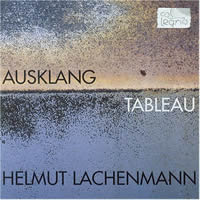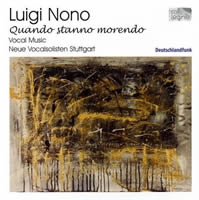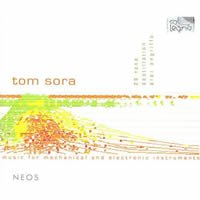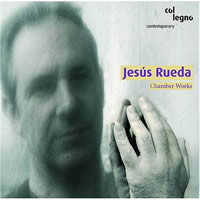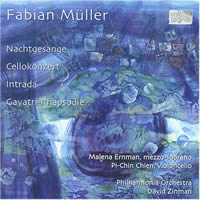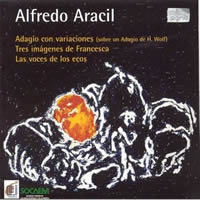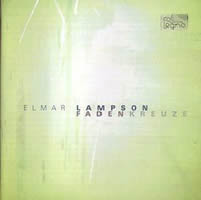Sticking with col legno
|
Grant Chu Covell [September 2006.] Col legno (http://www.col-legno.de/) ranks among those few labels for which I would blindly collect one of everything (mode, Metier, Kairos, Megadisc, Channel Classics and Cyprès are others). Wulf Weinmann, who captains the ship, maintains consistently excellent production levels. Sound and content are always superb. A grand pile of items, new to these shores courtesy of distributor Qualiton (http://www.qualiton.com/), await digestion. Finally an excuse to discuss Lachenmann! Let’s look at two headliners before considering unfamiliar names.
Helmut LACHENMANN: Ausklang — Musik für Klavier mit Orchester (1984/85); Tableau — Stück für Orchester (1988/89). Massimiliano Damerini (pno), Kölner Rundfunk-Sinfonieorchester (WDR), Peter Eötvös (cond.); Rundfunk-Sinfonieorchester Saarbrücken (SR), Hans Zender (cond.). col legno WWE 1CD 31862. Initially released in 1994, Qualiton has now lassoed this disc for American distribution. The composer’s estimable reputation amplifies difficulties for the newcomer to his music, which has never been easy to appreciate. Ausklang, a quasi piano concerto, comes from the period when Lachenmann receded from his concept of “rejection.” He had been ridiculed and severely criticized for his “negative” music — a succinct though crudely inaccurate label. His instrumental musique concrète embodies an aesthetic that requires fresh playing and listening techniques. As Cage embraced unintentional and non-music sounds, Lachenmann kept the instruments and discarded the rules. An early piano work, Guero (1970), treats the instrument as an artifact chanced upon by Sasquatch, perhaps, who can only think to tap, pinch and rub — anything but depress the keys. Detractors branded him a nihilist, a composer of “denial,” Henze being a particularly vociferous critic. Well-intentioned followers pounced upon Lachenmann’s modus operandi, filling the air with pale caricatures. Early studies with Nono (the German is generally accepted as the Italian’s leading disciple) taught the composer introspection, which helped Lachenmann to move on, rejecting rejection. After Ausklang he could no longer bear to be the “preacher raising his admonitory index finger in the wilderness of gagged scraping sounds.” So what’s it all about (Alfie)? The orchestra sounds like a shredded thesaurus haphazardly reassembled. The opening proves typically disorienting: Arrhythmic gasps from soloist and musicians, including an orchestral pianist, thwart any attempt on the listener’s part to discern a concerto. The solo piano busies itself in the foreground. One hears bursts of repeated notes (as an homage to American composer Charlemagne Palestine) and panicked tuttis. Contrasts and contradictions reign. Tonal chords appear like moonbeams. Somewhere the traditional four-movement symphonic form makes its mark. I’ve read that comparisons can be made with Strauss’ Alpensinfonie. The listener perceives a recurring Lachenmann shape: fast, very slow, fast. If this is indeed his purpose, the composer has done magnificently well at representing deterioration in music. Damerini easily negotiates an engrossing 50 minutes, recalling a fiendish Sciarrino disc. Especially beguiling are passages which capture the piano’s resonance, literally, the ausklang. The slightly later Tableau — for the present complete, with indications for a future appendage — attempts to organize Lachenmann’s orchestra according to rules (for me, incomprehensible). Thick with activity, all the “gagged scraping sounds” cavort in sumptuous bursts. Both works may seem alienating, but they’re also enormously invigorating and, in this listener’s opinion, necessary.
“Quando stanno morendo.” Luigi NONO: “Ha venido,” Canciones para Silvia (1960); ¿Dónde estás, hermano? (1982); Djamila Boupachà (1962); Sarà dolce tacere (1960); Quando stanno morendo, Diario polacco n. 2 (1982). Neue Vocalsolisten Stuttgart: Angelika Luz, Anja Metzger, Silke Storz, Annette Schneider-Spindler, Susanne Leitz-Lorey (sop), Stephanie Field, Christiane Schmeling (mez-sop), Barbara Stein (alt), Bernhard Gärtner, Martin Nagy (ten), Guillermo Anzorena (bar), Andreas Fischer (bass); Pirmin Grehl (bass fl), Erik Borgir (vlc), Manfred Schreier (cond.), Digital Masters Stuttgart (electronics). col legno WWE 1SACD 20603. A crystal-clear production, col legno collects a batch of Nono’s tricky a cappella works, laying bare their knotty serialism and treacherous demands. Consider the eight-part mixed chorus Sarà dolce tacere which itemizes many Nono tricks: clusters and piercing notes emerging from silence, precisely staggered entrances, and quintuplets set against triplets. The Neue Vocalsolisten Stuttgart takes it in stride. By comparison, older tapings are hesitant and crusty. With unisons that bloom into clusters, Ha venido is scored for solo voice backed by six sopranos. A 1968 Wergo Ha venido (WER 6038-2, Barbara Miller with Clytus Gottwald leading the Sopranchor der Schola Cantorum Stuttgart) rings fragilely. (Disc three in Bayer’s Atelier Schola Cantorum set, CAD 800 893, offers the same recording and a 1966 Sarà dolce tacere.) Soprano Luz commands the lead here and in the wraithlike solo Djamila Boupachà from Canti di vita e d’amore: Sul ponte di Hiroshima. Sarah Leonard’s Djamila on EMI 7243 5 55424 2 7 sounds remote, but EMI offers the orchestral bookends (Ingo Metzmacher leads the Bamberger Symphoniker). First performed on an Amnesty International concert dedicated to Argentina’s missing, ¿Dónde estás, hermano?’s close female quartet is mournful and questioning. Voxnova’s release (mode 87) offers a valid albeit quiet and timid reading along with Sophie Boulin’s Djamila. Dónde’s musical material derives from Quando stanno morendo. Nono’s asceticism can be wearying, especially considering how magically he could extend solo voices with tape and electronics (La fabbrica illuminata, Ricorda cosa ti hanno fatto in Auschwitz, etc.). After austere a cappella textures, nothing prepares for the pulsing electronics buried within Quando stanno morendo, Diario polacco n. 2, a late Nono composition employing electronic manipulation and spatial arrangements. Conceived for loudspeakers ringing the audience, Quando is a perfect candidate for SACD: The electronically enhanced cello pizzicatos thunder like artillery. In October 1981, the Warsaw Music Festival invited Nono to participate. But when martial law was declared in December, plans were abandoned and Nono lost contact with his Polish colleagues. The abruptly changing circumstances only strengthened the idealist’s resolve to complete the work. Quando’s nine sections set Massimo Cacciari’s arrangement of texts by Czeslaw Milosz, Endre Ady, Aleksandr Blok and Velemir Khlebnikov. Joining four female voices, bass flute and cello dominate the center where their growls and whispers are delayed and layered, thus creating a terrifying wall. Delicate, non-vocal, otherworldly sounds appear in movement Ib. Deliberately paced, at 42:01 this Quando is considerably more full-bodied though not noticeably slower than a 33:30 composer-supervised taping on Dischi Ricordi (CRMCD 1003). A 35:34 recording on the “25 Years EXPERIMENTALSTUDIO Freiburg” set (col legno WWE 3CD 20025) is ethereal and less frightening. As was his practice, Nono would have altered tempos to compensate for new venues. The greater length is valid when one takes into account the recording venue’s acoustic opulence. I hear an inadvertent pun in the second movement: When the electronically manipulated flute and cello appear, the audible text includes mosca, Italian for both Moscow and fly.
“Donaueschinger Musiktage 2004.” Benedict MASON: felt | ebb | thus | brink | here | array | telling (2001). Ensemble Modern. col legno WWE 1SACD 20604. “Music for Mechanical and Electronic Instruments.” Tom SORA: 20 Töne (1993-98); Destillation (2002-04); Drei Angriffe (2003). Tom Sora (windup music box, voices, pnos). col legno WWE 1CD 40001. Two separate col legno discs chronicle the 2004 Donaueschinger Musiktage. One CD houses pieces by Rebecca Saunders, Pierluigi Billone, Michel van der Aa, and Andreas Dohmen (WWE 1CD 20245). The other captures Mason’s oddly titled spectacle, one of the best releases to land on American shores this year. Equally elusive, beautiful and bizarre, Mason’s music blends the Ensemble Modern’s traditional instruments with metal tubes, wooden blocks, glass sheets, clay pots, etc., in often electronically assisted spatial arrangements. Nono is a clear spiritual forebear. Some noises are subtle, “virtually unrecordable,” because of their varied distribution within Donaueschingen’s Baar-Sporthalle. Even on CD playback, the aural impact impresses. The work’s 12 parts each explore different sounds, several demanding immediate replay: “No. 5 for three spaces” and “No. 6 for [D]oppler waves.” Each section could easily have blossomed into overtime; however, Mason prefers teasing succinctness. Sora takes us on a trip just beyond Nancarrow’s exit. 20 Töne groups several pieces for a hand-cranked music box. Beneath the subtle and tinkling Bach allusions one hears the paper coursing through the machine. Sora wholeheartedly explores his 20-note gadget’s potential. One piece has Sora singing in canon with his computer-manipulated double. The other works, for MIDI piano, continue along the same tack, imitating punched rolls and programmed cascades, abetted with distortion and spatial effects.
Robert M. HELMSCHROTT: 12 Sonate da chiesa (1984-1994). Var. performers. col legno WWE 2CD 20013. Michael DENHOFF: Hauptweg und Nebenwege: Aufzeichnungen, Op. 83 (1998). Vogler Quartet: Tim Vogler, Frank Reinecke (vlns), Stefan Fehlandt (vla), Stephan Forck (vlc); Birgitta Wollenweber (pno). col legno WWE 2CD 20029. Helmschrott’s mighty dozen couples the organ with various instruments. The two-movement sonatas are in four groups of three, two duets followed by a trio. The instruments are: 1, trombone; 2, oboe; 3, two trumpets; 4, trumpet; 5, flute; 6, trumpet and trombone; 7, cello; 8, violin; 9, violin and cello; 10, clarinet; 11, horn; and 12, three trumpets and three trombones. The final sonata expands the trio into a septet. Each sonata uses the same eight-note scale, B-C#-D-E-F-G-G#-A#, recalling Messiaen’s second mode of limited transposition. Helmschrott’s tart language does seem indebted to the great French master, along with other influences. With its two trumpets, Sonata III suggests Haydn and Hummel concertos, with the regal hocketing recalling an earlier age. The culminating Sonata XII folds in Orlando di Lasso’s Timor et tremor venerunt. Following a sequence of predominantly brass sonatas (despite Sonata II’s oboe), with its lighter, sometimes antiphonal, organ accompaniment, the reflective Sonata V, featuring the flute, sounds unmistakably French. As brass and winds can easily hold their own, I was keen to see how the composer would balance strings and organ. Frankly, that group is wanting: Their gallant gestures notwithstanding, one wants the cello to soar, as it does in Messiaen’s Louange à l’Éternité de Jésus. Helmschrott (b. 1938) seems more at home with brass. The sonatas would make excellent concert recital pieces. Spanning two discs (78:13 + 79:03), Denhoff’s piano quintet collects 365 miniatures, one for each day in 1998. Hauptweg und Nebenwege’s scale recalls Feldman, but this composer’s expressive, atonal language cycles through its task restlessly, absent introspection. Literary quotes preface many of the days (we see this in the booklet), presumably to add a touch of gravitas. Part III momentarily passes through Tristan. In Part V, percussive, bell-like sounds appear. Part X adds more percussion and voices. The Hammerklavier visits Part XI, and later, the violins and violist wander about the audience. At first hearing, Denhoff’s process appealed greatly, but the local organization and necessary monthly divisions (each apparently centering on a different pitch) seem arbitrary. Other than bill-paying, what sticks so religiously to the 12 months’ ends and starts? The composition seems less about paths, the wege, and more about endurance.
Jesús RUEDA: Cadenza (1997); Ítaca (1996); Concierto de cámara II (1997); Bitácora (1992); Mas la noche (1991); Sinamay (1991); Una leyenda (1990). Ananda Sukarlan (pno); Proyecto Gerhard, José de Eusebio (cond.). col legno WWE 1CD 20208. “a portrait.” Fabián PANISELLO: Trio II (1996); Japanese Pictures (1999); Moods II (2001); Fulgurar (1997); Presencias Tranparentes I (1990-91); Presencias Tranparentes II (1990-91); I don’t feel low (1999); Cuatro Poemas de Alejandra Pizarnik (1995). Plural Ensemble, Ensemble Varianti, Fabián Panisello (cond.). col legno WWE 1CD 20209. Two portrait discs reveal young composers finding their voices. Born in Madrid in 1961, Rueda studied with de Pablo and Guerrero and attended Nono’s summer class at Granada. Early acclaim came with Mas la noche, a compendium of contemporary trends ranging from Donatoni’s squirrelly gestures to Grisey’s spectralist harmonies. Discarding avant-garde clichés, the recent Concierto de cámara II rustles with neoclassical hints, Falla’s harpsichord concerto especially. Ironically, Rueda’s recent transparent textures push Proyecto Gerhard into harsh light: Instrumental timbres mattered less in the older, splashy works. Born 1963 in Buenos Aires, Panisello’s older pieces are loud and cavalier. Two recent works, Moods II and the piano trio, Trio II, replace frenzy with cool colors and shapely phrases. Though the piano solos Fulgurar and I don’t feel low are peppered with fast notes, their playful shapes suggest an allegiance to the sonic and practical rather than the needlessly ostentatious. This disc’s oldest compositions, the undistinguished Presencias Tranparentes, stomp through modern gardens. Perhaps reflecting his conducting experience, Panisello’s newer works reveal a better temporal sense.
Fabian MÜLLER: Nachtgesänge (1993/98); Konzert für Violoncello und Orchester (1999); Intrada (1998); Gayatri-Rhapsodie (1997). Malena Ernman (mez-sop), Pi-Chin Chien (vlc), Philharmonia Orchestra London, David Zinman (cond.). col legno WWE 1CD 20205. Alfredo ARACIL: Adagio con variaciones (sobre un Adagio de H. Wolff) (1997); Tres imágenes de Francesca (1990/91); Las voces de los ecos (1984). Orquesta Sinfónica de Tenerife, Victor Pablo Pérez (cond.); Orquesta Sinfónica de RTVE, José Luis Temes (cond.); Ameral Gunson (mez-sop), Orquesta Filharmónica de Gran Canaria, José Ramón Encinar (cond.). col legno WWE 1CD 20020. Young Müller (b. 1964, Switzerland) writes in a consistently romantic style — unexpected col legno fare! Perhaps Sterling should have released this. The warm Hesse settings, Nachtgesänge, could be mistaken for Szymanowski or Zemlinsky; indeed, Ernman sounds as though she’d be ideal in a Strauss opera. Darkly emotional, the single-movement cello concerto taps Shostakovich and Lutoslawski’s pathos; the idée fixe’s colorful unfolding reminds the listener of Dutilleux. Müller maintains his anachronistic mien, oblivious to neoclassical gestures or gratuitous avant-gardeisms. The other restless orchestral pieces touch less securely on the exotic, perhaps as Sibelius might have sounded trying to conjure Tibet. A rare example of contemporary slow music, Aracil’s fine Adagio frankly recalls Lohengrin via a movement from Wolff’s D-minor string quartet (the Auryn Quartett tackles this oddity on cpo 999 529-2). Darker and close to Mahler, Tres imágenes covers similar ground. Its final movement, El beso, for strings alone, gently hints at Barber. Listening to Aracil is like wandering alone through a museum at twilight, when shadows contort familiar works. Perhaps Silvestrov is an influence. Aracil achieves a remarkable transparency and facility exploring the DNA of earlier times. Las voces de los ecos’s second and final movement, Answering Looks, adds a soprano with words from Milton’s Paradise Lost.
“Chamber Music Vol. 1.” Nikolaus BRASS: VOID (1999); a due (2003); TRIO (1987-91/97). Monika Stöhr (pno); Hugo Noth (accordion), Susanne Schütz (vln); Kristi Becker (pno), Geoffry Wharton (vln), Roman Guggenberger (vlc). col legno WWE 1CD 20235. “Fadenkreuze.” Elmar LAMPSON: Streichquartett Nr. 2 (1992-96); Halleluja (1996); Vier Stücke für Violine und Klavier (1988). Danel Quartet: Marc Danel, Gilles Millet (vlns), Tony Nys (vla), Guy Danel (vlc); Wolfgang Sellner (vlc); Marc Danel (vln), Jan Michiels (pno). col legno WWE 1CD 20234. Merely 12:35, Brass’ calming solo-piano VOID conjures a majestic space through simple, repeated chromatic gestures and brash contrasts. The composer wrote it following a visit to the empty but otherwise completed new Berlin Jewish Museum. In A due, Brass plumbs the violin and accordion’s potential, answering pizzicati with reedy chords of unlimited duration. Frequently the pair cavorts at close range, contrasting fixed-pitch accordion with microtonal violin. Sedate outer movements shield a blustery center, and there’s whistling too. The lopsided two-part piano trio gently stammers, infrequently escaping from tonal gestures that hint at something absent or erased. The longer second movement begins with a forlorn violin solo the repeated gestures of which barely resist disintegration. Later, strident piano chords oppose gentle string harmonics. Where the first movement tries to remember, the last movement attempts to forget. The premiering musicians deliver committed performances, expertly balanced. Abiding by invisible rules, Lampson’s Second String Quartet flirts with amnesia and memory. Grand silences separate gently warped fragments — many sounding like Ravel castoffs — usually involving two or three of the quartet, leaving the other or others to spin quicksilver glissandi at the periphery. The notes make much of meaning and listening: Prof. Lampson teaches the “phenomenology of music.” Anything titled Halleluja or Vier Stücke becomes encumbered with references. Indeed, an earlier age saunters by in the solo-cello remembrance, Halleluja, a requiem for the composer’s father. Quite unlike Webern’s, Lampson’s Four Pieces invoke restraint. In the first, the violin sits on a single pitch for the full 4:22.
“Piano Works 1.” Diego MINCIACCHI: Klavierstück Nr. 1: Intermezzo da “Danza dell’ Angelo” (1979); Klavierstück Nr. 2: Three Times Form (1983); Klavierstück Nr. 3: COCKAMAMEY (1990); Klavierstück Nr. 4: Vae Victis (1996-97); Klavierstück Nr. 6: La connessione disumana – then – Sequitur clades, forte an dolo principis incertum (2003). James Clapperton (pno). col legno WWE 1CD 20239. “The Aforesaid.” Diego MINCIACCHI: EARTH WILL HAVE HER SAY …or… SAY WHAT? (if you’re searching for specific landmarks) (1990); The Lilliput-août Collection (1992-94); Ritual for the New Morning (1993 version) (1991-93); Cimeli Zoomorfi: … ich sah ein anderes Zeichen … or the … “Uncegila’s seventh spot” … (1994); “Westbau” from “Der Dom” (1992). Barrie Webb (trb), Laszlo Hudacsek (perc), Maurizio Barbetti (vla), Roberto Fabbriciani (flutes), Nicholas Isherwood (bass), Stefano Scodanibbio (contrabasses). col legno WWE 1CD 20277. Composer and neurologist Minciacchi has ambitions. Three piano pieces (Nos. 1, 2 and 4) reflect the Roman’s ongoing “dialog” with his native city. Unfolding steadily, the Intermezzo’s tonal contours create unresolved tension. Three Times Form casually plies Darmstadt concerns, whereas Vae Victis ups the ante, interspersing passionate action between Scelsian single-pitch reverberations. Pianist Clapperton compares the complex La connessione disumana (No. 6) to Xenakis’ Evryali, but nothing prepares us for COCKAMAMEY’s (No. 3) five-piano density wherein minimalist shenanigans grind against postwar chatter, here recorded by Curtis Roads, whose mixing has the pianos traveling back and forth across the soundstage. Minciacchi’s works with tape prove more compelling, as an alternate Vae Victis with tape and live electronics shows (col legno WWE 3CD 20025, on the “25 Years EXPERIMENTALSTUDIO Freiburg” collection). “The Aforesaid” groups five works for instruments and tape written between 1990 and ’95. Great players labor at Minciacchi’s transfer of complex procedures into the musical domain. The busily layered tapes usually derive from the accompanying solo instruments. In the apocalyptic EARTH WILL HAVE HER SAY, with trombone and percussion, the tape’s swirling brass masks the latter. The most successful pieces are the least homogenous: Ritual for the New Morning’s multiple flutes and tape includes bright guitar sounds which contribute a diverse backdrop for the scurrying flutes. Westbau, for bass voice, contrabass, trombone and tape, offers varied textures and densities, unlike the homogenous Cimeli Zoomorfi which stitches alto-flute to a tape with flute sounds and The Lilliput-août Collection, where the solo violist romps among coarse and scratchy caricatures.
Aracil, Brass, Denhoff, Helmschrott, Lachenmann, Lampson, Mason, Minciacchi, Müller, Nono, Panisello, Rueda, Sora
[More Grant Chu Covell]
[More
Aracil, Brass, Denhoff, Helmschrott, Lachenmann, Lampson, Mason, Minciacchi, Müller, Nono, Panisello, Rueda, Sora]
[Previous Article:
Guilty, Your Honor]
[Next Article:
Holst Seven, Matthews Nil]
|
